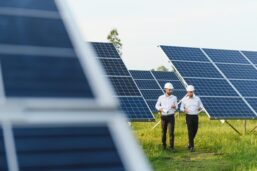Highlights :
- While transcontinental energy systems offer solutions to challenges in renewable energy growth, they face significant hurdles to reach their full potential
- Large electricity network across national borders demands extensive political cooperation and confidence in the political stability to safeguard substantial investments worth billions of dollars

From relying on oil and gas-based power to adopting renewable energy, the uneven spatial distribution and temporal variability of energy sources have historically favoured certain countries and continents over others. Transcontinental energy pools aim to address this disparity by distributing renewable energy to regions less fertile for harnessing these modern energy sources from the regions of abundance.
A study states that, if all suitable sites for renewable energy are available for development, transcontinental trade in electricity has the potential to reduce the annual system cost of electricity in 2050 by anywhere between 5–52 percent across six transcontinental power pools compared to no electricity trade.
Transcontinental energy systems can also solve the issue associated with present renewable growth. For instance, under land constraints, if only the global top 10 percent of suitable renewable energy sites are available, then without international trade, renewables are unable to meet 12 percent of global demand in 2050. Contrastingly, the transcontinental power pools with the same land constraints enable renewables to meet 100 percent of future electricity demand, while also reducing costs by up to 23 percent across power pools.
Woes of Transcontinental Energy Pools
While transcontinental energy systems offer solutions to challenges in renewable energy growth, they face significant hurdles to reach their full potential.
The Australia-Asia PowerLink project by Sun Cable highlights the ambition and challenges of transcontinental energy initiatives, including subsea cable installation and complex approvals. Similarly, the Xlinks Morocco-UK Link, with 2,360-mile-long cables, faced delays due to political issues in the UK, pushing its power generation timeline beyond 2027.
We look at the 5 major reasons why transcontinental RE projects remain a challenge.
#1 High Costs
Billions of dollars go into initial investments for establishing undersea cables transmitting power across oceans. Sun Cable’s Australia-Singapore link projected a preliminary estimated cost of USD 13.5 billion. While the Xlinks Morocco-UK Link project was initially valued at £20 billion (USD 24 billion), the mega project now is tagged between £22-24 billion (USD 27- USD 30 billion).
Elevated expenses often challenge the financial viability of these projects, making it difficult to secure investments and slowing progress. Budget overruns can lead to delays as additional funding is sought, further extending timelines. Moreover, high costs may restrict the adoption of advanced technologies crucial for efficient energy transmission across borders. Governments may also be reluctant to support such costly initiatives due to budget constraints and competing priorities. Furthermore, these projects may struggle to compete with more affordable local energy solutions, limiting their market competitiveness.
#2 Limited Suppliers of HVDC Cable
These mega projects require High Voltage Direct Current (HVDC) cables running in thousands of kilometers. North Atlantic Transmission One–Link (NATO-L), with a cable length of 3,500 km or 2,200 miles, aims to deliver a 6 GW high-voltage direct current (HVDC) set of subsea cables across the Atlantic to link North America and Western Europe. However, the limited number of HVDC cable suppliers poses significant challenges to this type of transcontinental RE projects. A few key manufacturers, such as Prysmian Group, Nexans, and NKT, dominate the HVDC cable market, controlling approximately 75 percent of it.
Dependence on a small number of suppliers increases the risk of disruptions due to geopolitical tensions, natural disasters, or other unforeseen events affecting production facilities. Further, the high demand for HVDC cables, coupled with limited manufacturing capacity, results in procurement lead times extending into multiple years. This delay can hinder the timely deployment of transcontinental renewable energy projects. Moreover, the limited competition led to higher prices for HVDC cables, affecting financial viability of the project.
#3 Political Issues and Energy Security
Geopolitics poses a major threat to a transcontinental project and may sometimes derail the projects altogether on political disagreements. The political quagmire is a summation of numerous minor issues that persist in bringing the multiple countries to agreement. For instance, creating transcontinental power pools requires a large-scale integration of regional transmission infrastructure, and thus has many challenges including grid ownership, stakeholder roles, financial responsibilities, and revenue allocation between participating countries.
Common policy frameworks and agreements need to be reached between national governments. Furthermore, Regional electricity markets and pricing mechanisms need to be established to coordinate between system operators across territories to facilitate power pool operations.
Energy security is also an often cited reason against such projects, as the country depending on power from another may find the risk too high. Be it Europe’s dependence on Russian gas, or in Asia, Bangladesh’s dependence on Indian electricity to an extent, energy security has often been cited as a key reason delaying these projects.
#4 Competition with Decentralised Systems
Transcontinental RE projects face significant challenges due to competition with decentralized energy systems. Decentralized systems, such as microgrids and localized renewable installations, offer advantages in flexibility, resilience, and cost-effectiveness. They enable communities to generate and manage their own energy, reducing dependence on large-scale infrastructure and enhancing energy security.
This localized approach can lead to faster deployment and lower costs compared to the extensive investments required for transcontinental energy transmission networks. Moreover, decentralized systems are often more adaptable to integrating renewable energy sources, aligning with the global shift towards sustainable energy solutions. Consequently, the growing adoption of decentralized energy systems presents a competitive challenge to the development and implementation of expansive transcontinental renewable energy projects.
#5 Land-use Challenge
Land is a limited resource. Land-use and resource availability present significant challenges for transcontinental RE projects. Renewable resource availability varies greatly by region. Areas with high renewable potential may face limitations in deploying infrastructure due to geographic constraints, population density, or environmental regulations. Large-scale renewable energy installations, such as solar farms and wind parks, require extensive land, which often competes with other critical uses like agriculture, conservation, and urban development.
Areas with high renewable potential may face limitations in deploying infrastructure due to geographic constraints, population density, or environmental regulations. These factors can exacerbate resource shortages in land-constrained regions, making international electricity trade critical for addressing demand gaps.



























